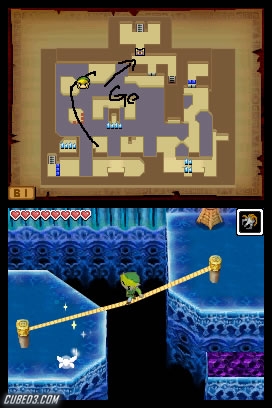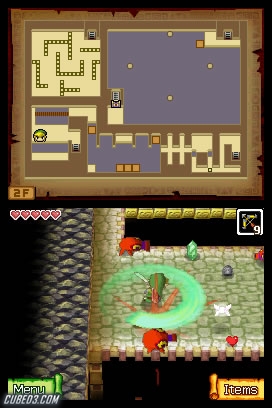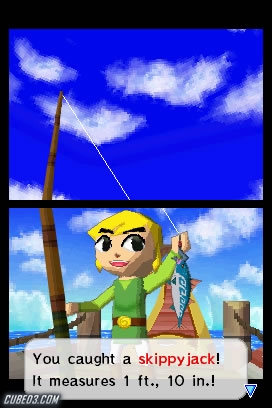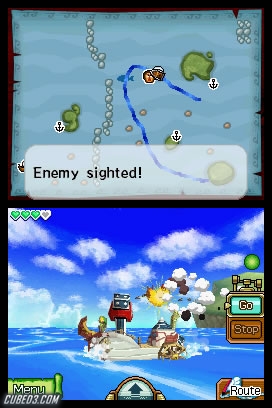The Legend of Zelda: Phantom Hourglass (Nintendo DS) Second Opinion Review
By Jordan Hurst  19.08.2016
19.08.2016

Seven years before The Legend of Zelda bridged 2D and 3D gameplay with the innovative painting-transformation mechanic of A Link Between Worlds, the series took a more straightforward stab at a 2.5D title with Phantom Hourglass. With a quick glance at some screenshots, it would appear to be a by-the-numbers 2D Zelda game spruced up with the presentation of The Wind Waker, but that's only half of what's happening here. Never content to just do one thing at a time, Nintendo also overhauled the series' controls and mechanics to employ the DS's unique capabilities as thoroughly as possible. The result landed in the upper echelon of glorified tech demos, but it was a glorified tech demo nonetheless.
99% of Phantom Hourglass is controlled using the touch screen, with buttons only occasionally functioning as shortcuts. To its credit, this setup allows for some genuine novelty in the series' standard mechanics; drawing elaborate paths for bombchus or the boomerang is a crucial, well-explored feature that truly couldn't be accomplished previously. The controls also add new life to a number of recurring minigames and are generally functional all-around. Their problem is that for the simpler mechanics like movement and sword combat, they're never as functional as regular buttons. It's an unnecessarily common event to take a step forward instead of attacking (and vice versa) because the DS didn't interpret your intention correctly. There was no reason (other than Nintendo's stubbornness) why the stylus couldn't have been used in conjunction with a more traditional control scheme for the best of both worlds.
The game takes every opportunity to announce what system it's on in other ways, as well, often leading to some of the most esoteric puzzles in the series. Some of these inclusions work better than others; the persistent map is a boon, and the boss battles frequently make excellent use of the platform's segmented screens. On the other hand, the moments that use the microphone are a classic case of having a feature just for the sake of having it. Yeah, it's kind of funny to accomplish stuff by shouting at the DS, but there's no functional reason it couldn't be relegated to a button press. It also doesn't have any depth as a game mechanic; it's just a confirmation window that needs to be yelled at to go away. Finally, there's the ability to write on the map, which is a great idea that too often devolves into receiving puzzle solutions in riddle form and saving them for later.

It's difficult to talk about Phantom Hourglass from a pure design perspective, because the unusual controls are so ingrained into the experience. For example, as this is a direct sequel to Wind Waker, the setting is still covered in a vast ocean, and seafaring is still a major component of the gameplay, but the water is now populated with a number of enemies and obstacles. In a review of a more straightforward game, this is where it would be mentioned that the naval combat is quite shallow, never expanding beyond shooting targets and blocking projectiles. However, that shallowness is only apparent here because the player's ship is controlled by drawing a pre-set course for it to steadily travel, completely removing movement from the combat equation. The waterborne obstacles actually exhibit some respectable variety; they just don't feel like it.
Similarly, the game is decently challenging, breaking the series out of the "easy era" that engulfed it from 2003-2006, but how much of that is by design is up for debate. Healing items are certainly less potent and plentiful, but there are several moments where Link will take damage simply because it's difficult to gauge how much acceleration a given screen tap will generate. It succeeds at providing some additional tension, but deliberately deriving challenge from cumbersome controls in a game that is neither a simulator nor an Octodad-style joke just feels cheap. One aspect of the game's design that can be talked about in independent terms is that initially, rupees appear to be a more valuable resource than usual. That is, until the ill-conceived "treasure" mechanic is introduced (wherein certain items are appraised differently in each playthrough, with one inevitably being absurdly lucrative), instantly deflating that possibility.
Despite all of these technical issues, the primary reason Phantom Hourglass rises near the top of its "tech demo game" peers is that it doesn't neglect the "game" part of that descriptor. The standard Zelda gameplay is respectably deep, the boss fights are inventive set-pieces, and the world has a greater sense of scale than most handheld adventures. It features a full complement of eight dungeons, most of which are expertly designed and incorporate unique, interesting mechanics, including one that's set in a semi-flooded ruin and one that requires switching between Link and a playable Goron. There's still the occasional cut corner - particularly the ship customisation that's only good for increasing stamina with matching pieces - but for the most part, this is a complete package with a fair amount of effort put into it.

That said, it must be noted that only most of the dungeons are expertly designed. One of them, the infamous Temple of the Ocean King, is a timed, stealth-focused "central" dungeon that must be constantly revisited to gain new instructions. It certainly shakes up the gameplay, which isn't a problem in and of itself, as the time limit is reasonably generous, and its invincible enemies are used in a variety of situations that make them more than just a token stealth obstacle. The problem is that all of the puzzles are reset with each new visit, and finishing the game requires at least five visits, getting deeper and more repetitive each time. If the area had included shortcuts to be unlocked with new equipment, it could have led to a solid sense of progression. Instead, new equipment is almost exclusively used to collect nearly-useless treasure chests, forcing players to re-sneak around every enemy and re-solve every puzzle over and over again.
This phoned-in quality is apparent in the game's artistic elements, too. Handheld Zeldas have historically gotten the short end of the stick when it comes to narrative significance, and this one is no different. It's functional on its own merits (barring some maddeningly predictable "twists"), but it kind of falls apart when examined as a sequel to Wind Waker. For instance, this new section of the Great Sea apparently houses a wish-granting ocean deity that no one thought to try recruiting in the fight against Ganon last year. Additionally, the ending includes an explicit parallel with that of Link's Awakening, but it makes absolutely no sense in context and is just fan-pandering for its own sake. The villain is also the flattest, least interesting antagonist in the series' history.

On the other hand, Linebeck, the new supporting character, is one of the funniest, most endearing entities in the franchise. It's unexpected, because he's actually nearly useless (he's the owner of the player's boat and is only in the adventure for the promise of treasure), but he injects the game with so much personality that it's difficult not to fall in love with his shenanigans. Speaking of personality, the graphics return to the "toon" style of Wind Waker, with all the vibrancy and expressiveness that that entails. Strangely, non-organic surfaces skew slightly more realistic, making their textures appear blocky on the weak 3D capabilities of the DS, but it doesn't detract too much from the overall charm. What does detract from it is the disappointingly lazy soundtrack. Half of the tunes are recycled from the game's predecessor, while the other half are the kind of simple, repetitive tracks that would be used only for small, nameless caves elsewhere in the series.
Finally, on a more positive note, Phantom Hourglass features a surprisingly enjoyable one-on-one multiplayer mode. In it, players compete across several maps, alternating between controlling Link and guiding three of the Phantom enemies from the Temple of the Ocean King. The goal is to avoid the Phantoms as Link while retrieving as many Force Gems from around the map as possible. It sounds fairly pedestrian, but it's livened up by the asymmetrical design, wherein Link is always visible to the Phantom player unless he's in a safe zone, while the hero's player can only see Phantoms on the map while carrying a Force Gem. The mode's inclusion is certainly not a major selling point (especially with the shutdown of Nintendo Wi-Fi Connection forcing local-only play), but it's a fun, original feature that can add an extra couple of hours of entertainment to the game's lifespan.

Cubed3 Rating
Good
The Temple of the Ocean King contains the skeleton of a fallen explorer who laments that if he could have only used the D-pad, he would have been fine, fourth wall be damned. It's a rare case of Nintendo being aware of its audience, but it's another example of how unaware of itself the company can be, because that skeleton is totally right. The fact that Phantom Hourglass comes on a DS card defines so much of its existence, and the parts that aren't characterised as such are a jumble of good and bad decisions. It's a testament to how amazing the Zelda formula is that a game as admirably experimental but ultimately misguided as this can still be decent just by implementing said formula.

![]() 9/10
9/10
![]() 9/10
(39 Votes)
9/10
(39 Votes)
 Out now
Out now  Out now
Out now  Out now
Out now  Out now
Out now Comments
Comments are currently disabled

 Sign In
Sign In Game Details
Game Details Subscribe to this topic
Subscribe to this topic Features
Features





 Top
Top

